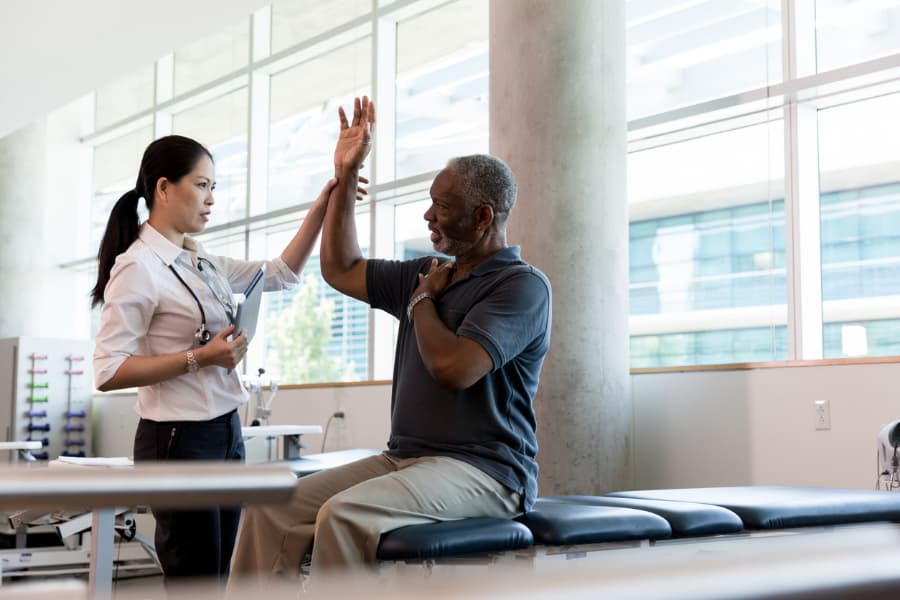Arthritis can lead to pain, swelling, and inflammation in a person’s joints. When a patient has arthritis in their shoulder, even basic tasks can become difficult, such as lifting a box or reaching up to a high cabinet. One option for treating severe shoulder pain and arthritis is reverse total shoulder replacement surgery. Learn more about how this procedure works and the potential benefits from Richmond University Medical Center in Staten Island, NY.
What Is Reverse Shoulder Replacement?
The shoulder has a ball and socket joint that connects the top of the humerus (arm bone) to the scapula. A group of muscles and tendons called the rotator cuff helps hold this joint in place. Arthritis and shoulder injuries can damage the ball and socket joint, making it difficult for a person to move their shoulder or lift their arm. In a conventional shoulder replacement procedure, a surgeon will implant a prosthesis that mimics the structure of the shoulder joint.
In contrast, reverse shoulder replacement flips the positions of the ball and socket. A plastic socket is attached to the upper arm bone, and a portion of the shoulder blade socket is replaced with an artificial ball.
This surgery is particularly effective for patients who have a torn rotator cuff. Rotator cuff injuries can happen because of an acute event, like a fall, or they can happen from wear and tear over time, especially from repetitive stress injuries. According to the American Academy of Orthopaedic Surgeons, nearly two million patients visit their physicians each year because of a torn rotator cuff.
A patient may be a good candidate for reverse total shoulder replacement surgery if:
- They have a torn rotator cuff that cannot be repaired
- They had a previous shoulder replacement that was unsuccessful
- They have limited range of motion in the shoulder joint and pain with movement
- Their shoulder joint suffered a complex fracture
- There is a tumor in their shoulder joint
- They have rotator cuff tear arthropathy, a complex form of arthritis
Generally, surgery is used as a last resort after more conservative forms of treatment have been unsuccessful. If treatment methods such as rest, medication, structured physical therapy, and cortisone injections have not helped a patient with their shoulder pain and inflammation, their physician may suggest surgery.
Pros and Cons of Reverse Shoulder Replacement
While reverse shoulder replacement is an inpatient procedure, many patients can go home from the hospital on the second or third day after surgery. The surgery usually takes about two hours and will be performed with either a general or a local anesthetic. After surgery, a patient will need to keep their arm in a sling and avoid heavy lifting.
Benefits of this surgery include:
- Shoulder pain is significantly reduced or goes away altogether.
- The patient regains their range of motion in the shoulder joint.
- The patient can resume lower-impact sports and activities.
No surgical procedure is without risk. With shoulder replacement surgery, there is always the risk of infection and other complications. Other potential challenges include:
- Bone fracturing can occur around the surgical implants.
- A patient may have some limitations in range of motion – for example, losing the ability to reach behind one’s back.
Patients also may experience pain or swelling at the incision site. However, physical therapy and pain medication can help make the recovery process easier. Full recovery can take several months, but the shoulder implant can last for many years.
Learn More From Richmond University Medical Center
If you or a loved one is suffering from arthritis pain and limited range of motion, talk with your physician about your options for shoulder surgery. Serving patients on Staten Island and in the surrounding area, the board-certified surgeons at Richmond University Medical Center perform over 10,000 surgical procedures each year.
In addition to reverse shoulder replacement, the orthopedics team at Richmond University Medical Center can provide the following shoulder surgeries:
- Labrum repair
- Revision rotator cuff repair surgery
- Shoulder reconstruction
- Shoulder resurfacing/partial joint replacement
- Shoulder stabilization
The hospital is accredited by The Joint Commission and has been designated as a Patient-Centered Medical Home by National Committee for Quality Assurance. To learn more about orthopedics and other specialty services at Richmond University Medical Center, contact us today.




